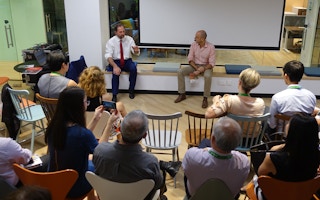Big multinational companies have started to work out how to build their businesses around the United Nations’ Sustainable Development Goals (SDGs). But what do the SDGs mean for the companies that make up the bulk of Asia’s business landscape – small-to-medium sized enterprises (SMEs)?
To continue reading, subscribe to Eco‑Business.
There's something for everyone. We offer a range of subscription plans.
- Access our stories and receive our Insights Weekly newsletter with the free EB Member plan.
- Unlock unlimited access to our content and archive with EB Circle.
- Publish your content with EB Premium.
This question was at the centre of the debate at an event held on 7 June, by Eco-Business and Business Council for Sustainable Development (BCSD) Singapore, to explore how companies can align their businesses with the SDGs – targets set by the UN in 2015 to tackle issues such as poverty, inequality and climate change.
World Business Council for Sustainable Development (WBCSD) vice president and COO Peter White commented that smaller businesses, which account for more than 97 per cent of businesses in the region, according to the Asia Pacific Economic Cooperation (APEC), are often a source of innovation needed to achieve the SDGs.
“In many cases, they [smaller businesses] can be the most sustainable and most innovative of all,” he said, adding that they may need to work with larger corporations to scale their sustainability efforts.
“A lot of the value here is in innovation – new ways to do things,” he said.
However, Genevieve Chua, managing director at Spicers Singapore, a supplier of sustainable print media, said that it was important to make the distinction between SMEs and start-ups.
In contrast to start-ups, she said it is difficult to persuade SMEs to align with the SDGs without some government involvement, such as a regulatory framework to guide their decision-making.
In response, White said the solution may come through the supply chain to provoke change, adding that a long-term shift in perspective was needed in the drive for sustainability.
Businesses, said White, “have to move to looking at creating true value, true cost and true profits, which don’t just rely on financial capital. They also take account of natural and social capital.”
This trend, he noted, was “beginning to gain traction.”
“
In many cases, they [smaller businesses] can be the most sustainable and most innovative of all.
Peter White, vice president and COO, WBCSD
White’s presentation was centred around the CEO Guide to the SDGs, a publication launched in March to encourage global business leaders to align their business strategies with the SDGs.
The guide aims to help unlock US$12 trillion dollars a year in business opportunities, and create more than 380 million jobs worldwide by 2030.
More companies are now using balance sheets that incorporate natural capital, as well as environmental profit and loss accounts in their decision-making processes, White said. Tools such as the Natural Capital Protocol can help companies to do this, he noted.
In the future, sustainability factors should be built into the system, commented White. Once companies are required to consider these factors in their reports and accounts, this will drive more sustainable behaviour for “purely economic reasons,” he said.
Chua further noted that, despite a growing green community in the region, Asian businesses tend to focus on the costs of sustainability rather than the opportunities it presents. So many are reluctant to change.
White commented that it takes time to increase consumer demand for green products, which is why businesses should look to improve the standards and efficiency of the production process. In the long-term, “more sustainable production, in terms of reliability, security of the supply chain” will be important, he said.
Sustainability and the real world
Teymoor Nabili, executive editor at Eco-Business, and moderator at the event, asked how the sustainability conversation could be brought out into the real world.
White responded that there are two parts to this conversation, innovation within companies, and talking to governments and municipalities about policy.
Companies, he said, can only go so far and a collaborative effort is necessary. “This is an ecosystem piece that you have to do together,” he noted.
Adam Lyle, executive chairman of innovation firm Padang & Co, noted that selling sustainable innovation opportunities to SMEs in Singapore is discouragingly difficult, as they seem to lack interest.
To White’s point on the importance of the supply chain, Lyle said that small businesses needed to show traceability and transparency in their sourcing. He then asked how the big companies under WBCSD could demand this change.
White referenced his past experience with Procter & Gamble as a possible approach. They required suppliers to report their energy use, waste, carbon emissions, and water consumption – the same factors that P&G reported on.
An annual improvement was expected and “those that did not perform well or did not report, did not get our business,” he said.










